
Kinetic 1/32 F-86F-30 Sabre
| KIT: | Kinetic 1/32 F-86F-30 Sabre |
| KIT #: | K 3201 |
| PRICE: | $36.95 MSRP |
| DECALS: | Two options |
| REVIEWER: | Tom Cleaver |
| NOTES: |

| HISTORY |
The North American F-86 "Sabre," like its predecessor, the P-51D Mustang, was fortuitous in its developmental history, and is one of those aircraft for which it can be said that had it not existed, history would be written differently today. The Sabre is definitely among the Top Ten most significant fighter aircraft in history.
Fortunately for the United States, the Nazis were stupid enough to chase Edgar Schmued from Germany in 1938 with their racial policies. The immediate result two years later was the P-51 Mustang, which resulted from a design he had been toying with while working at Messerschmitt - his Mustang was more responsible than any other Allied fighter for the aerial destruction of Nazidom; furthermore Schmued had no difficulty reading the captured German technical papers which discussed the advantage of the swept wing for jet powered aircraft as a way of delaying the onset of compressibility and therefore increasing speed; he had also been in attendance at the Volta Conference in 1935 where Buseman presented his paper on the theoretical superiority of swept wings in high speed flight. The result was the F-86 Sabre.
Unofficially, the Sabre was the first supersonic aircraft, achieving a speed
just in excess of Mach 1 in a dive two weeks before Chuck Yeager "broke the
sound barrier" in the Bell X-1. However, the Sabre was only capable of going
supersonic in a dive, while the X-1 went supersonic while accelerating in a
climb, making it the first “supersonic aircraft.” The F-86 and X-1 were
intertwined in other ways, because it was the research performed by the X-1 that
led to the creation of the "all flying tail," which greatly eased penetration of
the sonic barrier. The Sabre was the first operational aircraft to use this,
 and as a result, it was faster,
and more importantly more controllable at high speed, than its Russian opponent,
the MiG-15.
and as a result, it was faster,
and more importantly more controllable at high speed, than its Russian opponent,
the MiG-15.
The F-86 was first ordered by the Air Force on August 30, 1944. At that time the design had a strong similarity to what would emerge from Republic's design department as the F-84 Thunderjet. Fortunately, North American sent a team to Germany in July 1945 that included Edgar Schmued, who knew who to speak with among the Messerschmitt design staff, which resulted in his obtaining all the Messerschmitt high-speed research papers before anyone else. That August, Lee Atwood and Ray Rice were willing to listen to Schmued's report before the German research papers were officially translated. Armed with this information, Atwood went to the Air Force and got a year's delay on the delivery of the XP-86, which was time enough to add in the swept wings. It was likely the most important delay in aviation history. Had this not happened and the F-86 had come out of the shop looking like a slimmed down version of its naval counterpart, the FJ-1 Fury, the results of the aerial battles over Korea a few years later would have been very different indeed and the past 57 years of history would be completely changed.
The F-86A had only been operational for a year when it went to war. The appearance of the MiG-15 over the Yalu River in early November 1950 sent shivers through the Air Force, since the previously-unknown Russian jet was superior to everything in the inventory, with the possible exception of the F-86 Sabre. Within a month, the 4th Fighter Interceptor Wing - the descendant of the Eagle Squadrons and the 4th Fighter Group of World War II fame - was flying combat missions out of Suwon, Korea. For the next year, a force of Sabres that was never greater than 35-40 operational aircraft held off a Communist air command of several hundred jet fighters. The F-86A was followed a year later by the F-86E with the "all flying tail," and a bit less than a year after that by the F-86F which had an uprated engine and an extended wing leading edge without slats, for upgraded high speed and higher-altitude performance.
It is alleged that the Sabre achieved a kill ratio of 12.5:1 against the MiG-15. This has since been lowered to around 4.5:1 in the light of access to Soviet records after the end of the Cold War, and my friend and fellow aviation writer Robert Dorr has concluded it might only have been 3:1. In fact, the MiG-15 was generally superior to the F-86 above about 38,000 feet and could top out at 50,000 feet, which was superior to the Sabre's operational ceiling, and was always at least the Sabre's equal in climb and turn radius. What won the war for the Sabres was the edge provided by the greater skill and experience of its pilots, many of whom were aces of the Second World War, and all of whom were better-trained than their Communist opponents.
Joseph McConnell:
Joe McConnell, the leading American jet ace with 16 victories, first joined the Air Force during the Second World War. He flunked out of pre-flight training as a pilot for disciplinary reasons, and was trained as a navigator. He flew a combat tour in B-24s, then remained in the Air Force after the war, finally achieving his goal of becoming a pilot in February 1948.
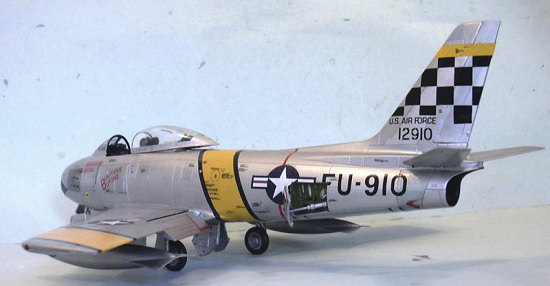 When the Korean War broke
out 18 months later, McConnell volunteered for combat, but was considered “too
old” (at 28) to fly jets in combat. This sort of “ageism” was soon set to rest
as the World War II pilots flying with the 4th FIW demonstrated that
experience was what counted. In August, 1952, when the decision was made to
re-equip the 51st Fighter Wing with Sabres, McConnell was among the
F-86 pilots who joined the Wing’s 39th Fighter-Interceptor Squadron.
Though he flew combat regularly beginning that September, he did not score
during 1952.
When the Korean War broke
out 18 months later, McConnell volunteered for combat, but was considered “too
old” (at 28) to fly jets in combat. This sort of “ageism” was soon set to rest
as the World War II pilots flying with the 4th FIW demonstrated that
experience was what counted. In August, 1952, when the decision was made to
re-equip the 51st Fighter Wing with Sabres, McConnell was among the
F-86 pilots who joined the Wing’s 39th Fighter-Interceptor Squadron.
Though he flew combat regularly beginning that September, he did not score
during 1952.
In January 1953, General Glenn Barcus, Commander of Far East Air Force, was able to get the rules of engagement changed to permit a more offensive strategy now that there were enough Sabres available to be more than a defense against the MiG force in Manchuria. McConnell scored his first victory on January 14, and was an ace by the end of the month. As one of the best shots in the Air Force, he frequently scored multiple victories when he entered combat.
On April 12, 1953, McConnell shot down his eighth MiG, but was then shot down himself moments later by Captain Semen Alexeievich Fedorets of the 913rd IAP, 32nd IAD. Fedorets had just scored his fifth victory against another Sabre when he spotted McConnell, who was chasing another MiG. Fedorets gained position just below and behind McConnell. When McConnell's wingman told him to break, he couldn't see Fedorets, who opened fire. The lethal burst of heavy cannon shells smashed the Sabre, nearly taking the wing off at the root and leaving a big hole where the main gear had been. Fedorets was sure of his victory when McConnell fell away. Despite the near-fatal damage, McConnell managed to force the F-86 into a high-G barrel roll that put him behind Fedorets. With the tables turned, McConnell shot up Fedorets’ MiG-15 so badly the Russian was forced to eject.
By this point, McConnell’s Sabre had lost half its power as well as the radio. Smoking, but not burning, he headed south, toward the China Sea. His element leader, 1st Lt. Harold Chitwood called the helicopter base on Cho-Do Island for air-sea rescue. Once over the water, McConnell ejected and was picked up by the waiting helicopter after only a few minutes in the water.
By the end of April, 1953, the Sabre force expanded with a third wing and the American forces were committed to achieving a victory that would end the stalemated Panmunjom peace negotiations. Communist forces put up strong opposition to these missions, and an “Ace Race” was on between McConnell, Captain Manuel Fernandez, and Major James Jabara, the first American jet ace who had returned for a second combat tour that month.
On
May On May 18, McConnell downed three MiGs in one day and became the first
“triple ace” of the Korean War with 16 victories. McConnell and his wingman,
Dean Abbott, chased two MiGs across the Yalu River into Manchuria in “hot
pursuit" - which was now permitted by the new rules of engagement. Before
McConnell could shoot down his first opponent, a large force
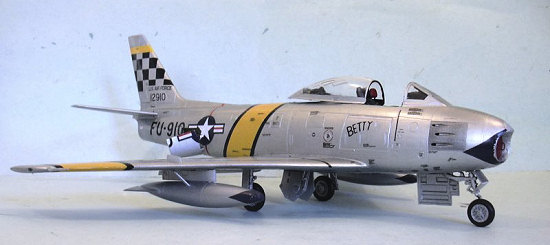 of MiGs showed up and the two
Americans were hard-pressed to out-fly their opponents. McConnell’s first
victory of the fight came when he shot a MiG off Abbott’s tail. A minute later
he shot another off Abbott’s tail for victory number 15. When Abbott radioed
that he thought there were 30 MiGs, the staff back at K-13 overheard McConnell
reply, "Yeah, and we've got 'em all to ourselves." As the MiGs ganged up on the
two, McConnell and Abbot hit “bingo” fuel and dove away south of the Yalu. In a
second mission that afternoon, McConnell got his third kill of the day.
of MiGs showed up and the two
Americans were hard-pressed to out-fly their opponents. McConnell’s first
victory of the fight came when he shot a MiG off Abbott’s tail. A minute later
he shot another off Abbott’s tail for victory number 15. When Abbott radioed
that he thought there were 30 MiGs, the staff back at K-13 overheard McConnell
reply, "Yeah, and we've got 'em all to ourselves." As the MiGs ganged up on the
two, McConnell and Abbot hit “bingo” fuel and dove away south of the Yalu. In a
second mission that afternoon, McConnell got his third kill of the day.
Informed of McConnell’s 16th victory, General Barcus is reported to have said, “I want that man on his way back home to the U.S.A. before you hear the period at the end of this sentence." McConnell was replaced as “D” Flight Commander by Major John Bolt, USMC, of the famed Black Sheep VMF-214, who went on to become the only Marine ace of the Korean War in the weeks of combat left before the Armistice. At the same time McConnell was sent back, Manny Fernandez was also sent home as the second-ranking ace with 14.5 kills. Left on his own, Jabara went on to steal Fernandez’ thunder by scoring 15 victories and nearly beat McConnell.
In the Fall of 1953, Warner Brothers Pictures began production of “The McConnell Story, starring Alan Ladd as McConnell and June Allyson as his stoic wife. Before shooting was finished on the movie, Joe McConnell was killed on August 24, 1954 at Edwards AFB flying an acceptance test of an early F-86H, which suffered a complete hydraulic failure. McConnell had practiced landing with just throttle and rudder many times in Korea, and he decided to stick with the airplane. As he turned to his final approach, ground turbulence lifted a wing. McConnell ejected, but was far too close to the ground.
“The McConnell Story” is still one of the best flying movies you can see and one of the most factually-accurate Hollywood war movies ever made (other than the fact that “Butch” McConnell was not the loyal wife portrayed in the film - but then June Allyson was never a “June Allyson character” either).
| THE KIT |
The
Sabre was first done in 1/32 scale by Hasegawa in 1972, and that has been the
only kit in the scale since until the advent of this new kit from Kinetic. The
Hasegawa kit is a long-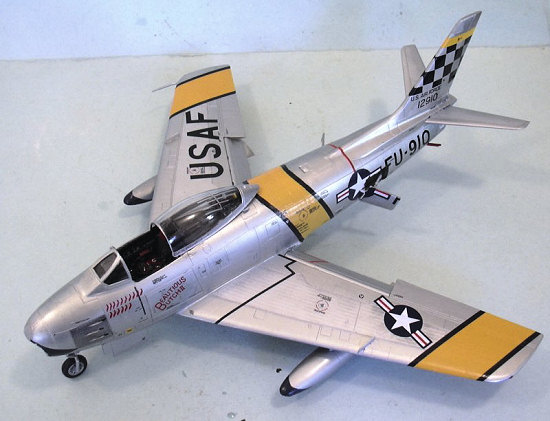 wing
F-86F-40, which means a modeler has to perform some surgery to create a Korean
War F-86. Additionally, there are accuracy issues with the size of the cockpit
and overall shape of the canopy.
wing
F-86F-40, which means a modeler has to perform some surgery to create a Korean
War F-86. Additionally, there are accuracy issues with the size of the cockpit
and overall shape of the canopy.
This new kit from Kinetic is interesting on several levels. First, it is obviously a pantograph of the Academy 1/48 F-86F-30. However, it is more of a “limited run” kit, with thick parts, thick sprues and gates, and soft surface detail. Fortunately, the Academy original is an accurate start, so the kit is a good F-86F-30.
Much ado was made of the surface detail of this kit when the first pictures were made available on the internet. Looking at those pictures, I was expecting a plastic abortion like the godawful Dragon P-51D. The good news is that the surface detail of this kit is actually quite accurate when compared to the two real F-86s out at Chino.
The decals provided are for McConnell’s second F-86 and for “Mike’s Bird.”
The kit provides a substantial metal weight, which will guarantee nose sitting even if you decide to include the engine - which will need a lot of work - in your finished model.
| CONSTRUCTION |
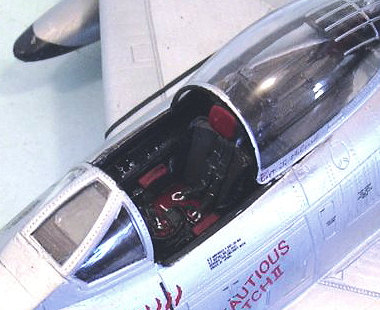 The initial appearance of
the kit is reminiscent of a 21st Century Toys kit - the parts are large and a
bit clunky, but they go together easily and present no fit problems. I had to
use Mr. Surfacer on all the seams and then rescribe the light rivet detail that
was lost with my pounce wheel. The end result when the kit is assembled is very
impressive.
The initial appearance of
the kit is reminiscent of a 21st Century Toys kit - the parts are large and a
bit clunky, but they go together easily and present no fit problems. I had to
use Mr. Surfacer on all the seams and then rescribe the light rivet detail that
was lost with my pounce wheel. The end result when the kit is assembled is very
impressive.
The most important thing I did with the kit was to use the resin detail parts created by Harold Offield of AMS Resin (hairold@verizon.net) . The gunsight, instrument panel, and control stick are all far superior to those provided in the kit. What is truly stupendous though is the resin seat he created. This is easily the most detailed seat I have seen. When painted, it really does “look real.” I strongly recommend you get this set from him - which now includes a detailed cockpit tub - because it vastly improves the final look of the model.
The kit provides full intake trunking, an engine and exhaust pipe. There is enough difficulty to getting a “seamless sucker” out of the intake that I took the easy way out and used the intake cover. What others can’t see won’t harm my reputation!
| COLORS & MARKINGS |
Painting:
I
was, quite frankly, a bit cowed by the idea of doing a model this big in a
complete natural metal finish. I had decided I would use the new Talon acrylic
metalizer paints. This was due as much to the fact it was too cold outside to
go airbrushing (which I have to do with lacquer-based paint or face the wrath of
SWMBO) as it was to curiosity about the paints. Several modelers have
complained in other forums that Talon paints will “bead up” when applied. In
fact, this will happen if the paint is applied to a bare plastic surface that
has been polished, due to the fact there is nothing for the paint to grab on
to. Gerald Voight told me his
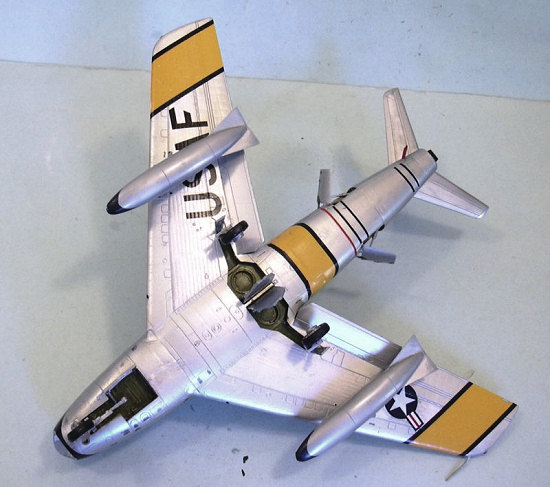 experience
was that applying the paint over a lightly-applied primer coat would keep the
paint from doing this, which I found to be the case.
experience
was that applying the paint over a lightly-applied primer coat would keep the
paint from doing this, which I found to be the case.
In using this paint on a model this big, one has to be sure that the primer coat is very smooth, since the paint will show any imperfection (which is why people polish their models before applying standard metalizer paints). I first applied Tamiya “Flat Aluminum” to the center sections of the wings and tail and the nose cap (which is plastic on the real thing), since my examination of the F-86s at Chino - which are unpainted - had revealed that the center section is a very flat aluminum and not the light grey many of us have thought was right. After I applied it, I realized it was too flat to allow decals to set right, so I applied a coat of Xtracrylix Satin Varnish. This solved that problem and I also realized that the Xtracrylix varnish, being very smooth and very thin, would work as a primer that wouldn’t fill in too much of the very fine surface detail. I gave the model an overall coat of Xtracrylix and let it dry for 24 hours before proceeding.
The entire model was painted with Talon “Platinum.” The ailerons, flaps, horizontal stabilizers, gear and dive brake doors and landing gear were painted with Talon “Aluminum.” Several other panels were masked and painted with Talon “Pewter,” which I then mixed with “Steel” to get the right shade for the gun ports. Once the model was unmasked, other panels were highlighted with SNJ Polishing Powder. The overall multi-hue metal effect is very subtle and looks quite realistic in comparison with color photos of Sabres in Korea. The gun-laying radar and the fin antenna housing were painted with Xtracrylix “Light Aircraft Grey” and the wheel wells and dive brake wells were painted with Xtracrylix “Interior Green.”
Decals:
I used the yellow ID stripe decals from an out-of-production Cutting Edge sheet. In retrospect, I think the kit decals would have been easier to use for these and will use them on future F-86s I do. I had the Super-Scale 1/32 sheet 32-22 “Sabre Aces”, and planned to use that. However, the markings for McConnell’s airplane are the “corrected” markings before the airplane was presented to the press, with the MiG silhouettes replaced by red stars and the name properly spelled. The kit provides the correct markings for the airplane when flown in combat, with the misspelled name. The font for the “U.S. Air Force” and serial number on the fin is wrong on the kit decals and right on the SuperScale decals. However, if you don’t have access to the aftermarket decals, what’s there in the kit will look fine and only those too anal to have fun with the hobby will complain about them. The kit decals are thin and go down over that very fine surface detail without any problem under an application of Micro-Sol.
| FINAL CONSTRUCTION |
I particularly like the wheels on this kit, with the rubber tires done in plastic, separate from the hubs. This allows pre-painting and results in a good-looking wheel, which is something many modelers have difficulty doing when they paint a single-part wheel. The landing gear went on without trouble, as did the drop tanks.
| CONCLUSIONS |
 The Sabre is easily one of
my two favorite jets (the other being the Panther), and this new kit from
Kinetic fills the need for an updated and accurate model of this famous
fighter. The model looks remarkably accurate when completed - had Dragon done
surface detail like this on their P-51, I’d have built ten of them without a
complaint. I am sure I will be building several more Sabres from this kit.
Given the really marvelous markings that were carried by Korean War Sabres, as
well as the many different nations that flew this wonderful airplane, one hopes
the aftermarket decal folks will get busy and provide more options. At an MSRP
of $36.95, the kit represents excellent value. It’s an easy model to build and
looks very impressive when completed. Highly recommended.
The Sabre is easily one of
my two favorite jets (the other being the Panther), and this new kit from
Kinetic fills the need for an updated and accurate model of this famous
fighter. The model looks remarkably accurate when completed - had Dragon done
surface detail like this on their P-51, I’d have built ten of them without a
complaint. I am sure I will be building several more Sabres from this kit.
Given the really marvelous markings that were carried by Korean War Sabres, as
well as the many different nations that flew this wonderful airplane, one hopes
the aftermarket decal folks will get busy and provide more options. At an MSRP
of $36.95, the kit represents excellent value. It’s an easy model to build and
looks very impressive when completed. Highly recommended.
Review kit provided by Stevens International.
December 2007
If you would like your product reviewed fairly and quickly, please contact me or see other details in the Note to Contributors.